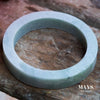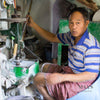How a Jade Bangle is Made Traditionally
Background
Jadeite jade is one of the two types of genuine jade which has been adored by in Chinese culture for many centuries. Before the discovery of Jadeite in Myanmar (Burma), Nephrite was the main mineral used in jewellery and ornaments. For much of the past century, Jadeite has become the quintessential gemstone for the Chinese. Valued not only for its beauty, durability and rarity but also for what it represents and the wealth, good luck and healing powers it posses.
The majority of the natural untreated jade bangles that supply the global markets are handmade in Myanmar. This article explains the processes of how a jade bangle is crafted from rough boulder to fine pieces of jewellery.
Choosing a Jadeite Boulder
The very first step of the process is to choose a Jadeite boulder. They can be bought from government auctions or local vendors. These boulder are covered by a layer of brownish to black coloured skin; different to the material underneath. Some of the boulders can have small windows where the skin is grind down so that the buyer can have an indication of what the quality of the material is inside. Others are cut in half and others have no indicators at all. Picking a jadeite boulder can be a gamble requiring both luck and skill because nobody can pin point where the good quality material is inside the boulder if any.

Jadeite slabs and halved boulders for sale by a local vendor at the Jade market in Myanmar.

A man stacks up a pile of un-skinned jadeite boulders with marking lines to be sliced open.
Slicing Jadeite Boulder
The jade boulder is then cut into slices of bangle thickness using large diamond coated blades with water dripping to act as lubricant and coolant. Being careful to check if any high quality veins have revealed after each slicing of the boulder.

Large blades driven by a piston engine are use to cut large boulders.

Jadeite slabs ready for inspection for placement of jade bangle templates.
The Perfect Placement
Once the Jadeite is in manageable slabs, workers draw outlines of bangles onto them. It's an important step, taking in to consideration these three factors: size, flaws and wastage. They would have to fit the maximum amounts of bangles on any given slab with the minimum amounts of flaws therefore, reducing wastage.

Two men discuss the best placement of bangle template to maximise value and minimise wastage.
Sizing
Most common jade bangle sizes are 52mm - 59mm depending on what the slab would permit. The workers will choose a size that would bring the most value out of the finished bangle. Sizes outside of the normal range are uncommon and require customised setups to carve and polish.
Flaws
Natural flaws are common and it's a compromise between quality and overall value when it comes to deciding the placement of the bangle templates on the slabs. The bangles can break in the drilling and polishing processes if the flaws are significant and not placed in the correct position.
Drilling the Jadeite Slab
With the outlines drawn, the slabs are securely placed inside a drilling machine fitted with double bladed diamond coated hole saws. The actual drilling takes place under water to keep the heat at bay which reduces the chance of breakage during the process.

The driller pulls down on the handle placing just enough pressure onto the slab that sits securely underwater.

A successful drilling process yields a perfectly round rough jade bangle.
Shaping into Style
The rough bangles are ready to be hand carved into the desired styles: round, semi-round, half-moon or flat. The technique uses two halves of a tough-gritted diamond flat lap to shape the rough bangle into style while its mounted on a spinning spindle.

A skilled worker shapes the rough bangle into the desired style.
Polishing with Bamboo
Once the desired style has been carved, the jade bangles are given their final polish using the traditional method used since the ancient times, bamboo. All polished jade bangles are given a rinse with water to wash off the residue abrasives and coated with wax to preserve the lustre.

The final polish is given using natural bamboo.

WAI YAN









